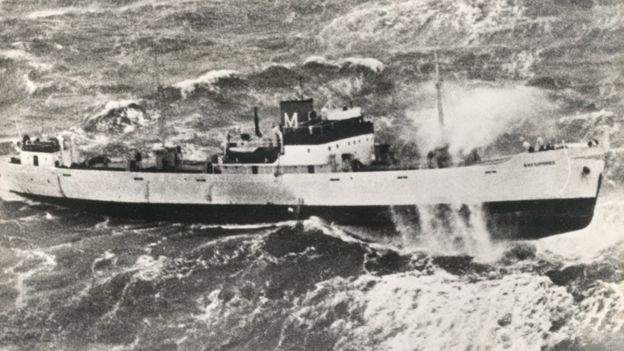Wales: Anglesey lifeboat crews reunite to remember stricken Nafsiporos rescue
The bravery of the lifeboat crews who face danger on the seas surrounding the Celtic coasts to save lives can never be underestimated. This was the case on December 2nd 1966 when The Nafsiporos a 1,287-ton Greek freighter with 19 crew members on board got into difficulties. In 100mph hurricane winds, with her engines having failed the boat was drifting dangerously towards the coast of Anglesey (Welsh: Ynys Môn) the island that lies off the north-west coast of Wales (Cymru).
Three lifeboats were launched. The first was the Manx RNLI lifeboat R A Colby Cubbin No 1 from Douglas (Manx:Doolish) who sought to chase the Nafsiporos as the storm drove her across the Irish Sea. Then the Holyhead (Caergybi) lifeboat St Cybi was able to launch at 10:30am from its Anglesey station. After a three hour search it was the Holyhead crew that eventually reached the stricken boat. At that time the Nafsiporos was just eight miles from the Anglesey coast and completely at the mercy of the storm with waves of 35ft.
The Holyhead lifeboat fought to get close to the freighter in extremely dangerous conditions. Climbing down a ladder the Greek crewmen on board then leapt to the lifeboat. Five crewmen made it to safety but then the Nafsiporos’ own lifeboat fell crashing onto the Holyhead boat, damaging it and forcing the crew to withdraw. Then a further RNLI lifeboat, which had already been out since 7am that day, assisting two other vessels, was launched from the Anglesey village of Moelfre. Fighting through enormous waves with very poor visibility the Moelfre boat was manoeuvred alongside the Nafsiporos. Ten of the crew were taken onto the lifeboat’s deck. On the tenth attempt, the lifeboat was swept onto the deck of the Nafsiporos, but then was washed off after a few moments. Badly damaged and without electrics and lighting, the Moelfre boat went to Holyhead to land the ten survivors. Four Greek crewmen, including the captain were still on board the Nafsiporos, having refused to abandon ship.
Even after all of this the lifeboat went out again to stand by the Nafsiporos through the night. Then the following morning a Dutch tug managed to tow the ship and her remaining crew to safety. The RNLI awarded medals to every member of the Holyhead and Moelfre crews for their bravery, determination and gallantry. Despite the dangerous conditions and several near-misses, there were no fatalities and no casualties. The RNLI marked the event on Friday when remaining crew members reunited at an event to remember the rescue. A video message was played to them from one of the rescued Greek sailors, the Nafsiporos' Second Officer Anestis Rokopoulos, now 73 who gave thanks to the rescuers for saving his life.
Lifeboat crews put their lives at risk in often perilous conditions in their aim to prevent loss of life. Sadly over the years lifeboat crews have lost their lives during acts of outstanding bravery. We are now approaching the tragic anniversary of the Penlee lifeboat disaster. This occurred off the coast of Cornwall (Kernow) on 19 December 1981. The Penlee Lifeboat Solomon Browne went to the assistance of the ship Union Star after its engines failed in heavy seas. They faced conditions similar to the Holyhead and Moelfre crews with 100 mph winds and waves cresting to 60 feet and in total darkness. The tiny Penlee lifeboat was repeatedly hurled onto the Union Star's deck, then swept off again but the crew managed to grab four of the stricken ship’s crew and get them aboard the lifeboat. They bravely sought further rescue attempts but tragedy struck. Both vessels were lost with all hands; in all, sixteen people died including eight volunteer lifeboatmen.
Lifeboat crews know the risk in which they place themselves but that does not stop them seeking to save lives. It is important and fitting that the RNLI marked the Anglesey lifeboat crews rescue of the sailors from the stricken Nafsiporos 50 years ago. They are owed a great debt of gratitude as are all lifeboat crews who bravely face the danger of the seas in pursuit of saving lives.

- Mair Williams's blog
- Log in to post comments





